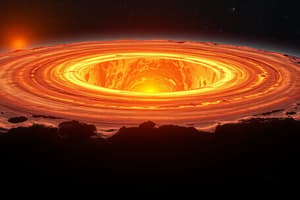Podcast
Questions and Answers
What does the process of Accretion primarily involve?
What does the process of Accretion primarily involve?
- Formation of oceans from vapors
- Disintegration of celestial bodies
- Attraction of materials through gravity (correct)
- Compression of existing planets
What is a protoplanet?
What is a protoplanet?
- A fully formed planet
- A type of asteroid formed from comets
- A planetary embryo made of collected matter (correct)
- A planet with a solid core
What characterizes homogeneous accretion?
What characterizes homogeneous accretion?
- It involves diverse types of material
- It occurs from materials of the same composition (correct)
- It results in a planetary lack of differentiation
- It exclusively creates gas giants
Which of the following is a limitation of the Accretion hypothesis?
Which of the following is a limitation of the Accretion hypothesis?
What is implied about the speed of the Accretion process?
What is implied about the speed of the Accretion process?
How does the Accretion theory explain the density differences among terrestrial planets?
How does the Accretion theory explain the density differences among terrestrial planets?
Which of the following statements about Earth is true?
Which of the following statements about Earth is true?
Which of the following is NOT a subsystem of Earth?
Which of the following is NOT a subsystem of Earth?
What layer of the atmosphere is primarily responsible for weather events?
What layer of the atmosphere is primarily responsible for weather events?
What is the primary composition of the hydrosphere?
What is the primary composition of the hydrosphere?
Which layer of the geosphere is liquid?
Which layer of the geosphere is liquid?
The ozone layer is found in which layer of the atmosphere?
The ozone layer is found in which layer of the atmosphere?
Which layer of Earth is the outermost and solid?
Which layer of Earth is the outermost and solid?
Which of the following correctly describes Earth's age?
Which of the following correctly describes Earth's age?
Flashcards are hidden until you start studying
Study Notes
Accretion
- Accretion is a leading theory explaining Earth's formation through gravitational attraction of small particles.
- The process leads to the creation of planetesimals, which subsequently form protoplanets characterized as planetary embryos comprised of matter collections.
- Homogeneous accretion occurs when Earth forms from materials of similar composition during condensation, resulting in a differentiated planet as it grew.
Evidence for Accretion
- Provides a mechanism for the presence of volatile elements in Earth's core.
- Explains density variations observed among terrestrial planets.
Limitations of Accretion Theory
- Cannot account for the high abundances of osmium, iridium, ruthenium, and rhodium in the mantle.
- Requires an accelerated accretion speed (10³ to 10⁴ years) that conflicts with the accuracy of large impact craters.
- Does not align with predicted abundances of iron, calcium, titanium, and aluminum.
Earth’s Characteristics
- Earth is the third planet from the Sun, and the fifth in the solar system.
- It is the only known planet to support life and is approximately 4.54 billion years old, with a margin of error of 50 million years.
- Named "Earth" from an English and German root meaning "ground," unlike other planets named after mythological figures.
Earth’s Four Major Subsystems
- Atmosphere: Comprises all gases surrounding Earth with distinct layers.
- Geosphere: Encompasses all landforms including soil, rocks, and minerals, extending from the surface to the inner core.
- Hydrosphere: Contains all of Earth's water in various states; consists of 97.5% saltwater and 2.5% freshwater.
- Biosphere: Includes all living organisms on Earth, integrating with other subsystems.
Atmosphere Details
- Made up of gases with five layers:
- Troposphere: Area where weather occurs.
- Stratosphere: Home to the ozone layer.
- Mesosphere: Region where meteors incinerate.
- Thermosphere: Where Aurora Borealis and Aurora Australis occur.
- Exosphere: Outermost layer where satellites operate.
Geosphere Composition
- Layers of Geosphere:
- Crust: Outermost solid layer.
- Mantle: Middle layer, primarily liquid.
- Core: Innermost layer, solid and composed mainly of iron and nickel.
Hydrosphere Characteristics
- Encompasses all water forms: vapor, liquid, and ice.
- Composed predominantly of saltwater (97.5%), with only 2.5% being freshwater.
Interaction of Subsystems
- Each subsystem interacts with the others, facilitating numerous geological and biological processes crucial for sustaining life on Earth.
Studying That Suits You
Use AI to generate personalized quizzes and flashcards to suit your learning preferences.




